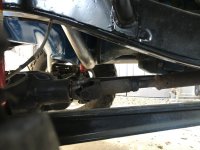jamesroney
Sr. Member
In the rear it is definitely not horizontal between the yokes. Or if any were from the factory, I never saw it.
Even if they were though, then I say that after modifications to the suspension are made, the correct angle becomes even more critical.
So basically for a double-cardan joint you don't go by the output yoke of the transfer case, you go by the driveshaft itself as your reference line.
As James said it would optimally be inline with the driveshaft, but in the rear on our leaf spring vehicles and lots of "axle wrap" we've typically seen the best results from a rear pinion angle that's just below the centerline of the driveshaft. About 1 to 2 degrees down seems to work best.
Any more than that and you get vibrations under deceleration. Any less than that and you get vibrations under heavy acceleration.
If you have a 4-link suspension, or a semi-rigidly located setup like our radius arms in the front, then just aim the rear pinion right up into the shaft.
Although I've always heard that just a little offset gave the grease and needles just a little workout that kept them happy. Seems to not be needed here I suppose, since the book said zero degrees. In the case of leaf springs too, without any anti-wrap device, your rear-most joint still gets that "angularity workout" under normal use.
Just to be clear, that means that your front pinion is pointed 5° below the driveshaft centerline, correct?
And did you happen to check the rear while you were under there?
Thanks.
Paul
Pinion inclination of 5 degrees means that the pinion points in a direction that is 5 degrees from horizontal when the axle is mounted in the vehicle. So the pinion points 5 degrees up. If you extend the pinion centerline back a couple of feet...it would hit the transfer case CV yoke dead center.
On a level surface, the pinion points uphill 5 degrees, and the driveshaft points downhill 5 degrees...and they are perfectly co-linear.
For the purpose of simple communication, I always reference the axle angles to an imaginary reference where the axle would be if the caster were set to factory specs.
So I will often say that the pinion inclination is 5 degrees, and the caster is 4 degrees...and the included angle (which is the wrong term...) is 9 degrees.
So a Dana 30 front axle has a 9 degree included angle. Meaning that when the pinion is up 5, then the caster is back 4. Give yourself 9 degrees of caster, and the pinion points perfectly horizontal. Give yourself 0 caster, and the pinion points up 9 degrees.
That is the angle that matters when you cut and turn the inner C's. Usually I'm building them starting from a bare housing, and there are no wedges installed. I know that as long as I put 9 degrees between the inner c and the pinion...then I will be able to attach the wedges with whatever bushings you want to use. It's a colossal PITA to install the pinion yoke, roll the axle under the truck, install the driveshaft, aim the pinion at the transfer case, then try to install the inner C at 7 degrees, while it's hot...before it shrinks, under the Bronco. You always end up tapping it with a hammer, and the whole thing moves. Then you have to take it out to weld it, take it back apart...etc.
To be clear, I never actually build a 9 degree Dana 44...because that's what the factory made, and it's bad for a lifted Bronco. A Bronco with 3.5 inches of lift needs 7 degrees of caster, and 12 degrees of pinion inclination...for a 19 degree included angle. This is why you hear people saying that they needed to rotate the knuckle 10 degrees.
The same 3.5 inch lifted Bronco with a high pinion D44 only needs 7 degrees of pinion inclination, for a 14 degree included angle.
My stock height U13 has a 9 degree included angle, but I'm not about to cut and turn it. Its hard enough to steer as it is. Besides, I need to finish this ProRock 60, (and I just put 14 degrees in it.) Wedges are only interesting if they are already on the housing, or if they are cast into the knuckle. Otherwise, I just weld them where they need to go.
I'm doing another one next week if you want to drop by.
...and yes, I allow for an additional 1.5 degrees of pinion climb in the rear of Broncos that are sprung soft. Your Wild H rock crawler springs like 2 degrees. If the rear axle is linked...then no.
Attachments
Last edited:











